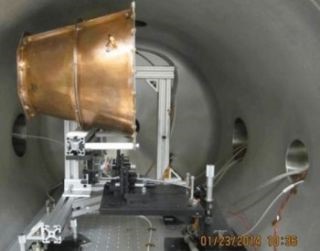
Last summer, NASA made international headlines after finally testing British scientist Roger Shawyer’s ludicrous EmDrive , otherwise known as “the impossible engine,” and determining that the engine produced a minute level of thrust without any propellant. This is major, because it goes against the very laws of physics as defined by Newton’s third law, that is, that every action has an opposite and equal reaction; hence the nickname “the impossible engine.”
Nearly eight months later, Paul March, an engineer at NASA Eagleworks, reported in a thread on NASASpaceFlight.com (a website devoted to the engineering side of space exploration) that NASA has successfully tested the EmDrive in a vacuum and demonstrated that laser beams fired through the EmDrive’s resonance chamber exhibited fluctuations in velocity, with some beams appearing to surpass the speed of light.

As to the why this is occurring: NASA remains perplexed. NASASpaceFlight commenters suggested that the findings were accidental, “they were wondering where this ‘thrust’ might be coming from. One scientists proposed that maybe it’s a warp of the space-time foam, which is causing the thrust.” But if the “why” can be understood, up-scaled, and reliably replicated, then we’ve just uncovered the Rosetta stone of space exploration, otherwise known as warp speed.

Merch’s report on NASASpaceFlight.com outlines that NASA has tools in place to measure variances in the path-time of light. Using these tools, it was observed that “[the] signature (the interference pattern) on the EmDrive looks just like what a warp bubble looks like. And the math behind the warp bubble apparently matches the interference pattern found in the EmDrive.”
Until now, the EmDrive remained maintained a hefty air of contention for it remained untested in a vacuum environment, causing skeptics to argue that the measurable thrust from last year’s test may have arisen from an external environmental condition, such as atmospheric heating, or the natural thermal convection currents that arise from microwave heating. But now, we see that the latest batch of experiments proves otherwise; by functioning in a vacuum, the experiments would logically suggest that the EmDrive will function in space.
While the recent findings up-end this reservation, we still lack the totality we need. Paul March’s rallies together the greater community of scientists, engineers, and enthusiasts outside of NASA, per say, who through their bouts of intuition, may contribute to furthering the knowledge and filling in the gaps.
“The NASASpaceflight.com group has given consideration to whether the experimental measurements of thrust force were the result of an artifact. Despite considerable effort within the NASASpaceflight.com forum to dismiss the reported thrust as an artifact, the EM Drive results have yet to be falsified.”
Source: NASASpaceFlight.com
Advertisement
Learn more about Electronic Products Magazine





